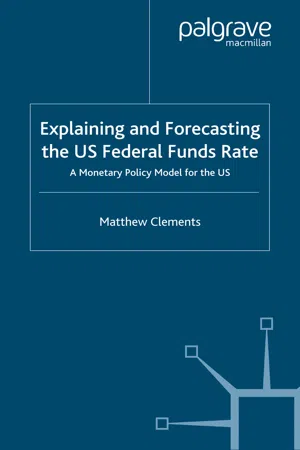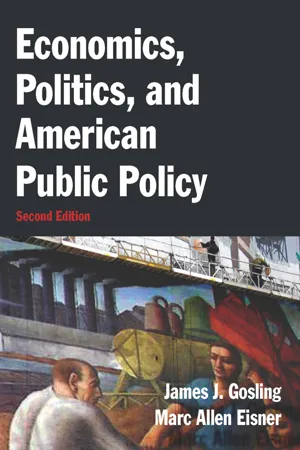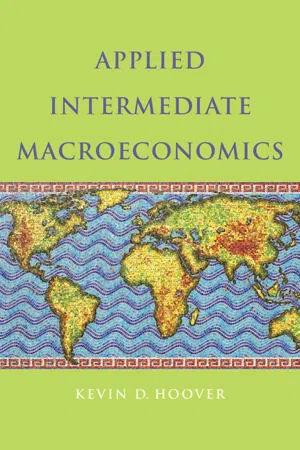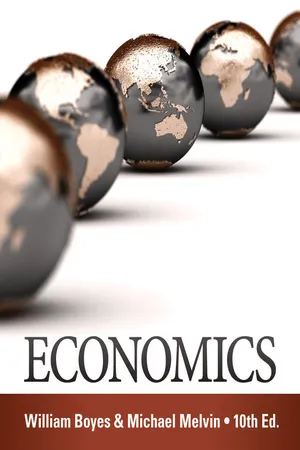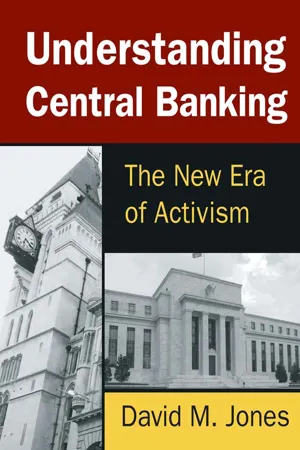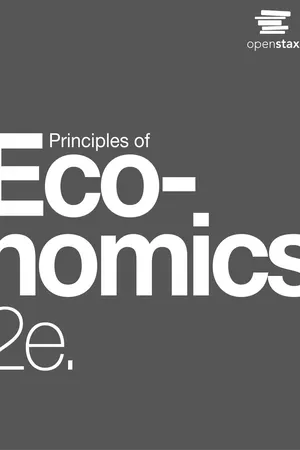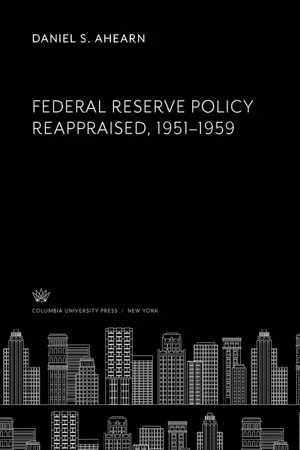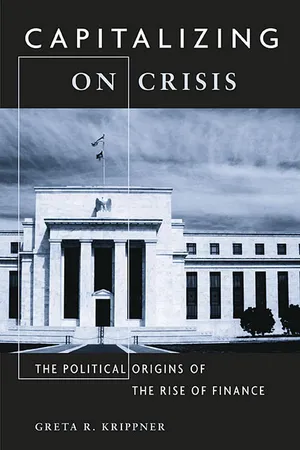Economics
FED Monetary Policy
The Federal Reserve's (FED) monetary policy refers to the central bank's actions to manage the money supply and interest rates to achieve economic goals such as price stability, full employment, and sustainable economic growth. It involves tools like open market operations, discount rates, and reserve requirements to influence borrowing, spending, and investment in the economy.
Written by Perlego with AI-assistance
Related key terms
1 of 5
12 Key excerpts on "FED Monetary Policy"
- eBook - PDF
- Jeff Madura(Author)
- 2020(Publication Date)
- Cengage Learning EMEA(Publisher)
108 Part 2: The Fed and Monetary Policy Summary ■ ■ The Fed uses monetary policy to achieve its goals of low inflation and low unemployment (strong economic growth). By using monetary policy, the Fed can affect the interaction between the demand for money and the supply of money, which affects interest rates, aggregate spending, economic growth, and inflation. ■ ■ A stimulative monetary policy involves increasing money supply growth, which reduces the federal funds rate and other interest rates. This policy is intended to encourage more borrowing and spending by businesses and households, which can increase economic growth. ■ ■ A restrictive monetary policy involves reducing money supply growth, which increases the federal funds rate and other interest rates. This policy is intended to discourage more borrowing and spend- ing by businesses and households, which can reduce economic growth. Such a strategy is intended to reduce excessive demand for products and services that could cause demand-pull inflation. ■ ■ The Fed faces a trade-off when implementing mon- etary policy. Given a possible trade-off, the Fed tends to pinpoint its biggest concern (unemployment versus inflation) and assess whether the potential benefits of any proposed monetary policy outweigh the potential adverse effects. ■ ■ Because monetary policy can have a strong influence on interest rates and economic growth, it affects the valuation of most securities traded in financial markets. Financial market participants attempt to forecast the Fed’s future monetary policies and the effects of these policies on economic conditions. When the Fed implements monetary policy, financial market participants attempt to assess how their security holdings will be affected and adjust their security portfolios accordingly. ■ ■ The Fed’s monetary policy must take into account the global economic environment. A weak dollar may increase U.S. exports, thereby stimulating the U.S. - eBook - PDF
Explaining and Forecasting the US Federal Funds Rate
A Monetary Policy Model for the US
- M. Clements(Author)
- 2003(Publication Date)
- Palgrave Macmillan(Publisher)
INTRODUCTION The Fed describes monetary policy as ‘actions undertaken ... to influ- ence the availability and cost of money and credit to help promote national economic goals’. The Federal Reserve Act specifies that in conducting monetary policy, the Federal Open Market Committee (FOMC) should seek ‘to promote effectively the goals of maximum employment, stable prices, and moderate long term interest rates’. The Fed controls the three main tools of monetary policy: open market operations (the FFR), the discount rate, and reserve require- ments. This book examines only the FFR, which is influenced by open market operations, the buying and selling of securities, which is the Fed’s primary instrument for controlling monetary policy. The FOMC is responsible for open market operations and setting the FFR. The committee comprises 12 voting members and meets at eight scheduled meetings a year. The FFR is the interest rate at which depository institutions (banks) lend balances at the Fed to each other overnight. Changes in the FFR in turn affect other interest rates, both long and short term, such as government and corporate bonds, mort- gage and credit rates. The exchange rate of the dollar is also sensi- tive to changes in the FFR. Using this rate, the Fed can affect the price of money and credit. In this way it influences employment, output and inflation. Strictly speaking, the Fed’s mandate of ‘price stability’ is a misnomer. Price stability means, by definition, zero inflation. Also, CHAPTER 2 Monetary Policy at the US Federal Reserve 27 the mandate does not specify which inflation measure should be targeted. In reality, the Fed looks to achieve inflation stability using an inflation measure that it considers to best represent price move- ments across the economy. In February 2000, the Fed ostensibly signalled a preference for the Commerce Department’s Personal Consumption Expenditure (PCE) price index as its chosen inflation measure. - eBook - PDF
- William Boyes, Michael Melvin(Authors)
- 2015(Publication Date)
- Cengage Learning EMEA(Publisher)
top: ª Carsten Reisinger/Shutterstock CHAPTER 13 Monetary Policy Preview In the previous chapter, we saw how banks “create” money by making loans. However, that money must get into the system to begin with. Most of us never think about how money enters the economy. All we worry about is having money available when we need it. But there is a government body that controls the U.S. money supply, and in this chapter we will learn about this agency—the Federal Reserve System and the Board of Governors that oversees monetary policy. The amount of money that is available for spending by individuals or businesses affects prices, interest rates, foreign exchange rates, and the level of income in the econ-omy. Thus, having control of the money supply gives the Federal Reserve powerful FUNDAMENTAL QUESTIONS 1. What does the Federal Reserve do? 2. How is monetary policy set? 3. What are the tools of monetary policy? 4. What role do central banks play in the foreign exchange market? 5. What are the determinants of the demand for money? 6. How does monetary policy affect the equilibrium level of real GDP? VvP/Dreamstime.com 277 Copyright 2016 Cengage Learning. All Rights Reserved. May not be copied, scanned, or duplicated, in whole or in part. Due to electronic rights, some third party content may be suppressed from the eBook and/or eChapter(s). Editorial review has deemed that any suppressed content does not materially affect the overall learning experience. Cengage Learning reserves the right to remove additional content at any time if subsequent rights restrictions require it. influence over these important economic variables. As we learned in the chapter titled “Fiscal Policy,” the control of government spending and taxes is one of two ways by which government can change the equilibrium level of real GDP. Monetary policy as carried out by the Federal Reserve is the other mechanism through which attempts are made to manage the economy. - eBook - ePub
- James Gosling, Marc Allen Eisner(Authors)
- 2015(Publication Date)
- Routledge(Publisher)
Unlike fiscal policy, for which Congress directly exercises its constitutional power to tax and spend, Congress has vested the authority for monetary policy in an independent government agency, the Federal Reserve. The Federal Reserve sets national monetary policy by influencing the availability and cost of credit in the United States, as it affects the level of reserves that financial institutions have available to lend to willing borrowers and the interest rates charged.Monetary policy can be employed to stimulate the economy. By increasing the supply of money, interest rates can be reduced, which creates incentives for corporations to make major capital purchases. Moreover, if loanable funds become available at an attractive rate, and if would-be consumers believe that interest rates are more likely to go up rather than down later, that perceived lower cost of money might just be enough to get them to borrow and make the investment. Monetary policy can also be an effective tool in an overheated economy. The objective in that condition is to lower aggregate demand, trading off reduced inflation for some increase in unemployment. Monetary policymakers act to tighten the availability of credit and increase its costs. A steep increase in the cost of loanable funds creates a disincentive for credit-financed spending. Consumers and businesses tend to wait for more favorable interest rates. If enough people behave that way, aggregate demand declines, unemployment rises, and inflation drops.It is far more difficult to control long-term interest rates, which are set in a highly competitive market in which borrowers bid for capital. But, as noted, monetary policy can influence short-term rates. Not only does the short-term cost of loanable funds affect the relative willingness of borrowers to take on debt, short-term interest rates send important signals about what the future economy might portend. Investors who believe that a modest increase in short-term interest rates presages a series of future increases are less likely to purchase long-term securities than are those who see a solitary adjustment acting to nip inflationary tendencies in the bud. Thus, interest rate changes, the way they are positioned by monetary policymakers, and the perspectives of would-be investors can all influence the behavior of participants in capital markets. - eBook - PDF
Economics
Theory and Practice
- Patrick J. Welch, Gerry F. Welch(Authors)
- 2016(Publication Date)
- Wiley(Publisher)
Generally, monetarists believe that controlling the money supply is the main vehicle for controlling economic activity. Some monetarists favor increasing and decreasing the money supply to control unemployment and inflation, while others favor a constant annual increase in the money supply to pro- mote stable growth and prices. Monetarism is discussed in Chapter 9. Summary 225 UP FOR DEBATE S HOULD THE F EDERAL R ESERVE B E P LACED UNDER THE DIRECT CONTROL OF CONGRESS ? Issue Although the Federal Reserve is a creation of Congress and the Board of Governors is appointed by the president and confirmed by the Senate, policy decisions are made independent of congressional oversight. The policy decisions pursued by the Board of Governors have a signifi- cant impact on interest rates and economic activity. Some people argue that the Fed is too powerful to be so independ- ent, while others strongly favor a monetary authority that is independent of the political process. Should the Fed be placed under more congressional control? Yes The Federal Reserve should be placed under greater control of Congress. The actions of the Federal Reserve can change the direction of economic activity: Tools can be used to raise the interest rate and decrease spending in an effort to control inflation, or to lower the interest rate and increase spending in an effort to reduce unemployment. This ability gives the Board of Governors substantial power over the economy—power too great to be exercised independent of congressional approval. Because Congress is part of the political process, members of Congress may be more responsive to the wishes of the electorate. Congress may prevent interest rates from rising to levels that negatively impact house- hold and business borrowing, and may recommend that the federal debt be monetized when it is sizable. Finally, the chairperson of the Board of Governors is a powerful force: Markets throughout the world react to the chair’s statements. - eBook - PDF
- Kevin D. Hoover(Author)
- 2011(Publication Date)
- Cambridge University Press(Publisher)
Part VIII Macroeconomic Policy 16 Monetary Policy The chairman of the Board of Governors of the Federal Reserve System Ben Bernanke is frequently called the “second most powerful man in the United States.” His immediate predecessors, Alan Greenspan and Paul Volcker, were similarly regarded in their days. How is it that an unelected public servant should be widely regarded as having an influence over the state of the nation second only to the pres-ident of the United States? Our goal in this chapter, indirectly, is to answer that question. The short answer is straightforward: the chairman of the Federal Reserve stands at the center of monetary policymaking in the United States. But that just raises other questions: Why is monetary policy so important? How does monetary policy work? To answer those questions is the main business at hand. 16.1 Monetary and Fiscal Policy Monetary policy is one of the two main types of macroeconomic policy. In Chapter 13 (section 13.2) we defined the other type, fiscal policy , as compris-ing those government actions that aim to influence macroeconomic perfor-mance through the manipulation of government revenue (taxes) and gov-ernment spending (both on goods and services and on transfer payments). M ONETARY POLICY comprises those government actions that aim to influ-ence macroeconomic performance through the financial system . Although we touched on monetary policy in the discussion of the financial system in Chap-ter 7 (section 7.6.1), a complete picture needs much more detail. The main discussion of fiscal policy is in Chapter 17. Nonetheless, because monetary and fiscal policies are not independent, we shall consider their relationship in this section. 16.1.1 The Government Budget Constraint Like all agents in a free-market economy, the government must pay for the goods and services it receives. When tax revenues fall short of expenditure (i.e., it runs a deficit), the government must raise the money some other way. - eBook - PDF
- William Boyes, Michael Melvin(Authors)
- 2015(Publication Date)
- Cengage Learning EMEA(Publisher)
§ 13-2a • Some countries have adopted inflation targeting to guide their monetary policy. § 13-2a 3. What are the tools of monetary policy? • The tools of monetary policy are the reserve require-ment, the discount rate, open market operations, quantitative easing, and forward guidance. § 13-2b • The Fed buys bonds to increase the money supply and sells bonds to decrease the money supply. § 13-2b • If the policy interest rate is near zero, a central bank may use quantitative easing to further stimulate the economy and buy financial assets to flood the market with money. § 13-2b • The Federal Open Market Committee (FOMC) issues directives to the Federal Reserve Bank of New York outlining the conduct of monetary policy. § 13-2b 4. What role do central banks play in the foreign exchange market? • Central banks intervene in the foreign exchange mar-ket when it is necessary to maintain a targeted exchange rate. § 13-2c 5. What are the determinants of the demand for money? • The demand for money stems from the need to buy goods and services, to prepare for emergencies, and to retain a store of value. § 13-3a • There is an inverse relationship between the quantity of money demanded and the interest rate. § 13-3a • The greater the nominal income, the greater the demand for money. § 13-3a • Because the Fed sets the money supply, the money supply function is independent of the interest rate and real GDP. § 13-3a 6. How does monetary policy affect the equilibrium level of real GDP? • By altering the money supply, the Fed changes the in-terest rate and the level of investment, shifting aggre-gate demand and the equilibrium level of real GDP. § 13-3 R E C A P 1. The transactions demand for money is a demand to hold money to buy goods and services. 2. The precautionary demand for money exists because not all expenditures can be planned. 3. The speculative demand for money is created by uncertainty about the value of other assets. - eBook - ePub
Big Picture Economics
How to Navigate the New Global Economy
- Joel Naroff, Ron Scherer(Authors)
- 2014(Publication Date)
- Wiley(Publisher)
Chapter 9 Monetary Policy: Money, or Maybe the Federal Reserve, Makes the World Go ’RoundThe Fed is assumed to be all-knowing and all-powerful: wrong and wrong. How monetary policy works is discussed in this chapter, but much more important, how the same policy can be successful or a failure depending on the type of policy and the context in which it is implemented.In the past two chapters, we saw how difficult it is to create fiscal policy even if the government wasn’t as dysfunctional as it is. Whether it is raising taxes or lowering them, how that is done, and the economic implications are frequently unknown even to those making the decisions. Worse, the differential effects of alternative policies may not even be a factor in many fiscal policy decisions since politics rather than economics usually drives taxation decisions.When it comes to the expenditure side of the budget, be it cutting spending, funding massive stimulus projects, or implementing mindless sequestration, the government rarely has any idea what it is doing. There are even politicians who think it is possible to balance the budget. In other words, fiscal policy is more a matter of political dogma and expediency than any logical or rational approach to economic growth.In the face of all that chaos, the members of the Federal Reserve have to determine what is the best course for monetary policy. Is this a job that even Superman would hesitate to take on? Probably. But someone has to do it, and it does get done—often better than anyone could imagine.How Monetary Policy Works
The Federal Reserve came into being in 1914 largely because people basically didn’t trust banks. And they had very good reason to worry. No, it wasn’t just because Butch Cassidy and the Sundance Kid were riding around robbing banks and trains. Essentially, banks operate in a perpetual state of bankruptcy. They take in money and usually lend out more than they have on hand. That creates a small problem called liquidity - eBook - ePub
Understanding Central Banking
The New Era of Activism
- David Jones(Author)
- 2014(Publication Date)
- Routledge(Publisher)
Some observers have proposed that nominal GDP growth serve as a central bank target, but, as argued at a recent press conference by Fed chairman Bernanke, a nominal GDP target may take a number of years of Fed effort to hit. Moreover, once the nominal GDP target is hit, its real GDP and inflation components may deviate from the Fed’s desired levels. For example, a 5 percent nominal GDP growth target would, ideally, be composed of 3 percent real GDP growth and 2 percent inflation. But the actual target of 5 percent nominal GDP growth, when eventually hit, might instead consist of an undesirably high 4 percent inflation component and only 1 percent real GDP growth. The point is that it is the real GDP and inflation components, not the nominal GDP total, that are most relevant to Fed policymaking.POLICY INSTRUMENTSThe primary instrument of monetary policy is open market operations, which influence reserve market conditions and set the target for the federal funds rate. The federal funds rate is the rate on bank reserve balances held at the Fed that are loaned and borrowed among banks, usually overnight. Basically, depending on actual and expected economic circumstances, Fed policymakers adjust their federal funds rate target, which, in turn, influences short-term interest rates like the commercial paper rate and bank prime rate, as well as long-term interest rates such as corporate bond rates and mortgage rates together with the stock market (asset prices) and the U.S. dollar. Ultimately, the Fed is seeking to change interest rates in order to influence aggregate demand (consisting of personal consumption expenditures, residential fixed investment, business fixed investment, government spending, and net exports) with an eye toward increasing output. If aggregate demand is projected to be weak and output growth is below its potential, the Fed will cut its federal funds rate target. Conversely, if aggregate demand is projected to be strong and output growth is above its potential, the Fed will hike its federal funds rate target. When output growth is above its potential, slack in resource utilization will decline, posing the threat of increasing wage and price pressures. In contrast, when output growth is below its potential, slack in resource utilization will increase, thereby diminishing inflationary pressures. - eBook - PDF
- Steven A. Greenlaw, Timothy Taylor, David Shapiro(Authors)
- 2017(Publication Date)
- Openstax(Publisher)
The Fed should loosen monetary policy when a recession has caused unemployment to increase and tighten it when inflation threatens. Of course, countercyclical policy does pose a danger of overreaction. If loose monetary policy seeking to end a recession goes too far, it may push aggregate demand so far to the right that it triggers inflation. If tight monetary policy seeking to reduce inflation goes too far, it may push aggregate demand so far to the left that a recession begins. Figure 28.9 (a) summarizes the chain of effects that connect loose and tight monetary policy to changes in output and the price level. Figure 28.9 The Pathways of Monetary Policy (a) In expansionary monetary policy the central bank causes the supply of money and loanable funds to increase, which lowers the interest rate, stimulating additional borrowing for investment and consumption, and shifting aggregate demand right. The result is a higher price level and, at least in the short run, higher real GDP. (b) In contractionary monetary policy, the central bank causes the supply of money and credit in the economy to decrease, which raises the interest rate, discouraging borrowing for investment and consumption, and shifting aggregate demand left. The result is a lower price level and, at least in the short run, lower real GDP. Chapter 28 | Monetary Policy and Bank Regulation 677 Federal Reserve Actions Over Last Four Decades For the period from the mid-1970s up through the end of 2007, we can summarize Federal Reserve monetary policy by looking at how it targeted the federal funds interest rate using open market operations. Of course, telling the story of the U.S. economy since 1975 in terms of Federal Reserve actions leaves out many other macroeconomic factors that were influencing unemployment, recession, economic growth, and inflation over this time. - Daniel S. Ahearn(Author)
- 2019(Publication Date)
- Columbia University Press(Publisher)
214 CONTROL OVER FINANCIAL VARIABLES Yet highly respected economists have charged that since the Fed-eral Reserve has been in existence, the money supply has displayed excessive and even perverse movements in relation to economic ac-tivity. In view of this record, the critics say, monetary policy could make a greater contribution to economic stability and growth if the Federal Reserve gave up its attempts to control the money supply countercyclically and simply aimed at increasing the money supply (actual or potential) each year by some constant percentage rate, for example, 4 percent, related to the long-term annual rate of growth in real production. 1 This far-reaching recommendation would radically change, if not emasculate, central banking as we know it. Accordingly, close analy-sis of the evidence relevant to the criticism and suggested reform are indicated. The critics' argument runs as follows: (1) Fluctuations in the money stock since the establishment of the Federal Reserve Sys-tem have been far greater and more destabilizing than they were prior to the adoption of discretionary central bank control over the money supply; (2) The cyclical behavior of the money supply under Federal Reserve control has been destabilizing, with the volume of money or its rate of growth declining in recessions and rising in prosperity; and (3) A steady rise in the money supply at about the rate of growth in real gross national product would be more appro-priate to both the longer term and cyclical needs of the economy. The analysis will focus first on the question of whether the money supply has behaved as erratically and perversely as the critics claim, both in long-run and cyclical terms, and then will consider whether a policy of increasing the money supply by some constant percentage rate each year would be a desirable and feasible improvement.- eBook - PDF
Capitalizing on Crisis
The Political Origins of the Rise of Finance
- Greta R. Krippner(Author)
- 2011(Publication Date)
- Harvard University Press(Publisher)
33 No explicit statement of the change in policy was made; the committee merely noted that somewhat more rapid monetary growth would be per-missible in the context of “financial and economic uncertainty.” 34 Although the retreat from money supply targeting might have repre-sented a kind of tactical defeat for the FOMC, the episode had neverthe-less provided invaluable lessons. While the economy was left in a perilous position, inflation had been reduced from 13 percent when Volcker as-sumed his post to a quite respectable 4 percent; it would remain in this range through the end of Volcker’s tenure at the Federal Reserve in August 1987. It was quite an accomplishment, particularly given the fact that only a few years previously, policymakers were seriously beginning to doubt that they possessed the tools to bring inflation under control. In the end, the most critical tool belonged as much to the art of politics as it did to economics. Volcker and his colleagues had learned that if the Fed-eral Reserve could evade responsibility for setting interest rates, they could obtain “the flexibility to do what has to be done,” as President Cor-rigan urged. 35 In Claus Offe’s (1974) terms, policymakers had managed to “re-naturalize” the economy, returning to the market what had previ-ously been attributed to the state: the Federal Reserve only determined a noninflationary growth rate for the money supply; markets did all the rest. If the Federal Reserve was to return to some form of interest rate target, as appeared inevitable given mounting difficulties in calibrating M1 to real economic outcomes, then every effort would be made to retain this lesson of the monetary targeting episode. “Letting the Market Show Through”: 1982–1987 Central to the Federal Reserve’s strategy for maneuvering through this difficult period was the manner in which it communicated its policy in-tentions to the market and to the public.
Index pages curate the most relevant extracts from our library of academic textbooks. They’ve been created using an in-house natural language model (NLM), each adding context and meaning to key research topics.

